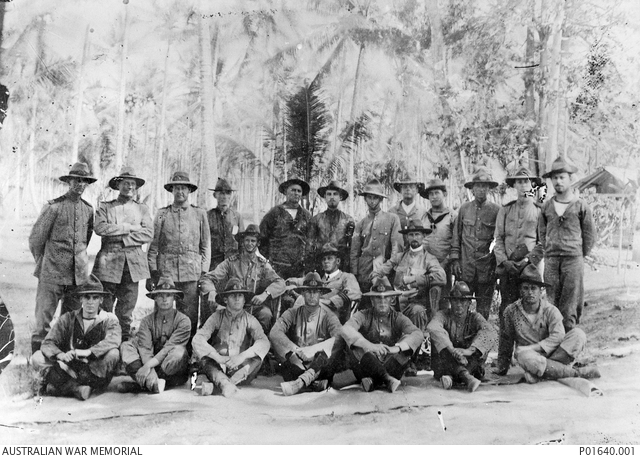Uniforms of the Australian Naval & Military Expeditionary Force
At the outbreak of the First World War Australia immediately pledged a contingent of 20,000 men in support of England. Within days Britain forwarded a request for an additional force to capture and occupy German possessions in the Pacific, particularly the wireless stations instrumental in communications used by the powerful German naval squadron based in the area. Nine days later, on 19 August 1914, a hurriedly equipped force of 1500 infantry, naval reservists and ex-seamen known as the Australian Naval and Military Expeditionary Force (ANMEF) embarked for Rabaul.
The standard dress for those below officer level in the land forces of the ANMEF was the most easily sourced at the time - the Universal Training Pattern militia uniform consisting of slouch hat or forage cap, woollen military shirt, cord breeches, puttees, ankle boots and 1908 Pattern webbing equipment.
Though standardisation of uniforms was preferred, contemporary images show that uniforms were far from uniform. Reflecting the deficits in war supply so early in the war, and the competing obligations to the AIF contingents, many wore their existing militia uniforms or even combinations of patterns. While the service dress uniform of the AIF was becoming more common by the time the ANMEF was disbanded in 1921, there continued to be a variety of patterns worn.
Unusual pocketless tunics of the Victorian members of the 3rd Battalion ANMEF 'Tropical Force', also known as the 'North West Expeditionary Force'. The 3rd Battalion left Australia to relieve the original ANMEF assault force in late November 1914.
This pre-war jacket was worn by Staff Sergeant George Thomas Collier while in the ANMEF, dating from his time with the Royal Australian Artilley. Many men with prior service wore their existing uniforms.
Soon after their arrival in the tropics, many of the army officers and administrative staff adopted a cooler white summer uniform, possibly made from cotton drill, similar to those worn by their naval counterparts. Local tailors were kept busy producing the new uniforms for the force.
The white summer suit adopted in lieu of the heavy woollen uniform issued.
Members of the Royal Australian Navy and the Naval Reserve who joined the ANMEF were, luckily, already outfitted for service. Nevertheless, the land roles of the naval personnel of the initial assault force in 1914 necessitated modifications to their existing uniforms, including dying them a darker colour and wearing slouch hats instead of the sailor's cap or officer's peaked cap.
Naval officers and ratings for the initial assault force dyed their white uniforms for fighting on land. Note also their use of the slouch hat with various 'bashings' or crown shape dent. Before the First World War bashings (or lack thereof) were not uniform and the hat shape varied dramatically.










